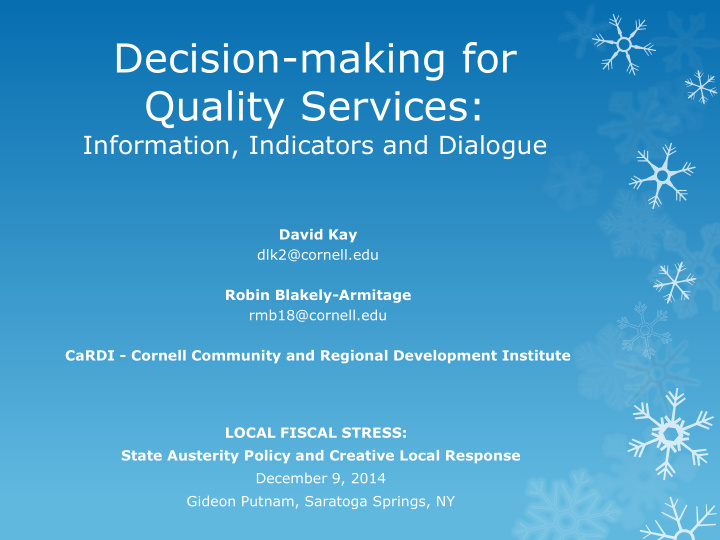



Decision-making for Quality Services: Information, Indicators and Dialogue David Kay dlk2@cornell.edu Robin Blakely-Armitage rmb18@cornell.edu CaRDI - Cornell Community and Regional Development Institute LOCAL FISCAL STRESS: State Austerity Policy and Creative Local Response December 9, 2014 Gideon Putnam, Saratoga Springs, NY
Overview Why Indicators? Trends in NYS local government spending Examples of Indicator Projects to support informed decision-making about government service provision Measuring Impact with Indicators
Why are we talking about indicators? Fiscal Stress Changes in Funding ? Impacts ? Informed Decision-Making means including a consideration of the consequences and impacts of these decisions How to measure impacts? Role of data and other indicators How to connect indicators to decision-making?
Trends in NYS Local Government Spending
Service Expenditure Trends What has happened to municipal service expenditures since FY 2007? Examples Counties Towns Source: NYS Comptroller Compared to inflation trends Source: State and Local Government Implicit Price Deflators, Federal Reserve Bank St. Louis
County Expenditure Trends by Service Area Major Expenses (10% or more of all spending) • • Spending Grew More or Less Than Inflation? • Social services (24%) < inflation • General government (17%) < inflation • Employee benefits (15%) > inflation • Public safety (12%) < inflation • Total expenditures (100%) < inflation
Debt Service: 5% of Expenditures Employee Benefits: 15% of Expenditures Total Expenditures: 100% of Expenditures
Town Expenditure Trends by Service Area • Major Expenses (10% or more of all spending) • Spending Grew More or Less Than Inflation? • Transportation (20%) < inflation • Employee benefits (17%) > inflation • General government (14%) < (declined absolutely) • Public safety (13%) = inflation • Sanitation (11%) < inflation • Total expenditures (100%) < inflation
220.0 Total Expenditures of Towns by Service Area (FY 2007=100) 200.0 180.0 General Govt Only transportation (20%), 160.0 general government (14%), Education and public safety (13%) account for more than 10% Public Safety of expenditures Health 140.0 Transportation Social Services 120.0 100.0 80.0 2007 2008 2009 2010 2011 2012 2013*
Examples of Community Indicator Projects that support informed decision-making about government service provision
Putting Indicators to Work http://www.communityindicators.net/
Social Services: Children
Public Safety
Public Safety
Public Safety Indicator: Violent Crime
Putting Crime Indicator to Work
Putting Indicators to Work
Connecting Indicators with Decision-Making
Cause & Effect & Indicators Funding enables activities which affect outputs M E which A influence S outcomes: U Immediate R A B Intermediate L E ? Long term Source: http://www.publicsafety.gc.ca/cnt/rsrcs/pblctns/2013-vltn-crm-prvntn-prgrm/index-eng.aspx
Connecting Indicators to Decision-Making A Project Proposal: “Understanding the Impacts of Fiscal Stress: Developing Community-Driven Indicator Models” Goals: Lay the foundation for establishing and measuring causal relationships between funding changes and community well-being. Support informed decision-making around fiscal issues. Provide communities with a process for exploring impacts of fiscal decisions. Approach: Work with community partners to develop logic models tracing likely cause/effect relationships Interviews to measure perceived local impacts Indicator sets developed to measure these impacts and track other trends. Questions: What methods do you currently use to estimate the impacts of your fiscal decisions? Do you think projects linking indicators to decision-making have the potential to be useful? Why or why not?
Recommend
More recommend